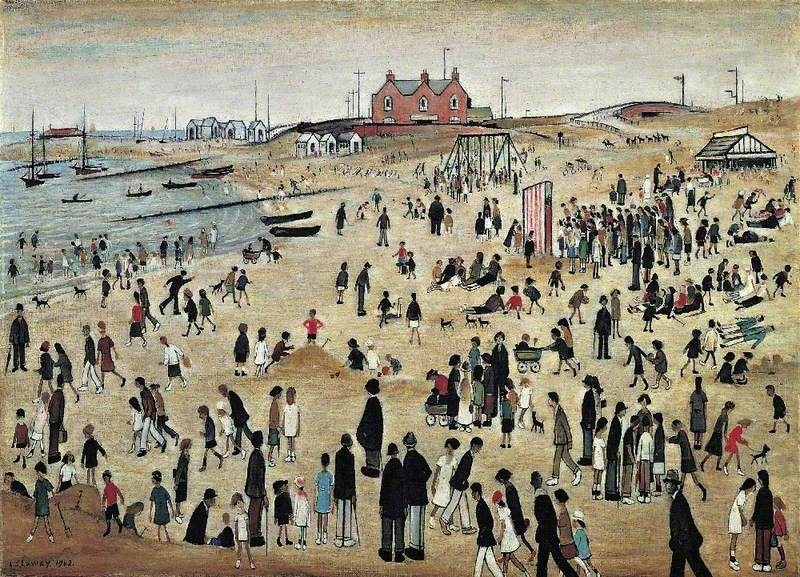In 2024, the Granary Gallery is taking a deep dive into LS Lowry’s (1887-1976) interest in seascapes, specifically of the North Sea, which he captured from the Northumberland coast over several decades.
Visitors to Lowry and the Sea will have the opportunity to see 20 of his works, including oil paintings, as well as drawings in pastel, charcoal, and pencil, both from public and private collections. Loans are supported by the Weston Loan Programme with Art Fund. Created by the Garfield Weston Foundation and Art Fund, the Weston Loan Programme is the first ever UK-wide funding scheme to enable smaller and local authority museums to borrow works of art and artefacts from national collections.
Although best known for his industrial paintings of Manchester and the surrounding area, LS Lowry began visiting the North East of England from the 1930s, with his first visit to Berwick-upon-Tweed around 1935. He became a regular visitor to the town until his death in 1976 capturing the town’s streets and buildings and views of the North Sea. Lowry was fascinated by the sea and had first been drawn to it as an art subject at just 8 years old and it had by now become increasingly important in his work Similar to his famed industrial works, he found an equally mysterious mood in the waves and winds, as he did in the smoke of Salford.

Lowry would capture the different vessels that he saw from the shore. In Yachts (1920, The Lowry Collection, Salford), they are dotted about under broken clouds, yet the view retains a calmness. A relaxed view of the sea continues with people strewn on the beach in Spittal Sands, Berwick (1960, Private Collection), while Waiting for the Tide (1965, Private Collection) conveys a ship peacefully floating in the distance.
Radical
But the spectre of industrialisation was still never far away. In Tanker (1965, The Lowry Collection, Salford) pollution appears to bleed into the murky green water and dirty sky. The dangers posed by seafaring are also captured, with Untitled (Sinking Ship) (undated, Estate of LS Lowry) rendering a capsized ship slowly hastening to the sea floor. The implicit peril caused by the wildness of the North Sea was a mood that Lowry returned to over the span of a half century, from the pastel-worked Stormy Seashore (1920, Estate of LS Lowry) to the painting Grey Sea (1970, Estate of LS Lowry).
Lowry has been celebrated for his radical and idiosyncratic approach to art, as well as the use of stark monochrome, and the exhibition highlights this. In the pencil work At Anchor (1963, The Lowry Collection, Salford) a bold black wave dwarfs a ship that appears almost suspended in a sea of white, while The Sea (1969, The Lowry Collection, Salford) utilises only short lines of blue ballpoint pen. Other-worldly features are also depicted in his seascapes, where a gigantic rock juts out of the water in Untitled (Rock in the sea) (1970, Estate of LS Lowry). In a curious and atypical ´self-portrait´, LS Lowry depicts himself as a monolith-like shape in Self Portrait as a Pillar in the Sea (1966).

Lowry’s relationship with the sea seems to evolve further after the death of his mother in 1939. After a trip to Anglesey, in 1944 he was bored ‘almost to death’ and unable to paint anything. About a month later he was back at home and started to paint the sea – ‘the sea that I had seen, nothing but the sea. But a sea with no shore and no boat sailing on it – only the sea’, He continued to paint these ‘empty seascapes’ for the rest of his life and two significant works from the 1960s demonstrate this in the exhibition – Seascape (1965, Arts Council Collection) and The Sea (1963, Lowry Collection, Salford).
Colour
The artist once said, “I have been fond of the sea all my life, how wonderful it is, yet how terrible it is”, and the works on display give a clear indication of this idea – the wrestling of opposing feelings – sometimes within the same picture. This can be seen in A Rainbow (undated, Estate of LS Lowry) where the arch does not stand out through colour or gradient, but by its imposing status over the vast expanse of the water´s surface. It is both a typical symbol of tranquility at sea, as well as an indicator of terror, demonstrated by its sheer size.
Many of the seascapes would be turned into limited-edition prints and become popular images of Britain´s coastline. Now, visitors to The Granary Gallery will have the opportunity to see up close the original sketches, drawings and paintings by LS Lowry in the place where he found so much inspiration over his decades-long celebrated career.
James Lowther, Head of Visual Arts at the Maltings says ‘We are delighted to present this new exhibition of original works by LS Lowry at the Granary Gallery. Lowry had a great affection for Berwick-upon-Tweed, evidenced by the number of works he produced of the town. These works provide a fascinating starting point to explore Lowry’s lifelong fascination with the sea and I’m sure the exhibition will of great interest to local people and visitors from far afield.’ }
Tickets for Lowry and the Sea (25th May- 30th October 2024) are available online on the Maltings website (maltingsberwick.co.uk), by telephone or by visiting The Box Office at The Maltings and the Granary Gallery. Tickets: £5, concessions will apply.















